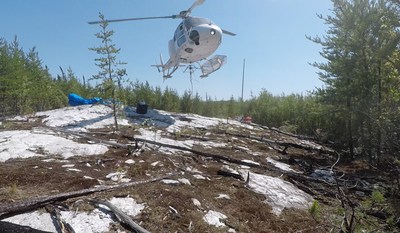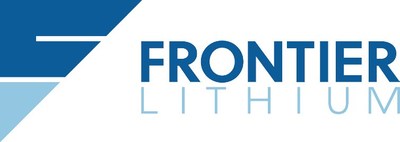Electric Avenue target confirmed by Channel Sampling 16 m of 2% Li2O 25 km from the PAK and Spark deposits
Highlights
- The entire channel of 16 metres grades 2% Li2O with a 12 m zone averaging 2.35% Li2O;
- The channel is part of a 1.5 km long pegmatite dyke;
- Electron-microprobe on Spodumene confirms low impurities similar to PAK;
- Substantiates fertility of Ontario's Electric Avenue for high-quality LCT pegmatites hosting rare low-iron spodumene.
SUDBURY, ON, June 10, 2020 /CNW/ - Frontier Lithium Inc. (TSXV: FL) (the "Company" or "Frontier") is pleased to report channel sampling results from Pennock, a third LCT (lithium, cesium, tantalum) pegmatite, on the PAK Lithium Project. A 1.5 km-long pegmatite dyke was located, which is intermittently exposed and contains white to light grey spodumene and lepidolite. The dyke is oriented in an east-west direction, cross-cutting the main trend of the Bearhead Lake Fault and culminates at a 16 m wide exposed "blow-out" near the western end (Figure 1). During the drilling program on Spark in July 2019, the support helicopter was used to transport a two-person crew to the main blow-out area of the Pennock pegmatite to complete the channeling.
Figure 1: Location and Compilation of the Pennock Showing Area
"The overall high lithium grade of the channel coupled with the presence of the unique mineral texture SQUI (spodumene-quartz-intergrowth) and corresponding low impurity spodumene is very exciting." states Garth Drever, VP Exploration. "This is another landmark on the Project supporting the Electric Avenue as a rare, high-quality North American corridor for LCT Pegmatites"
Summary information including the location of the channel and mineralized intercepts is shown in Table 1 while Figure 2 contains photographs of the blow-out area where the channel was cut.
Table 1: Summary of Channel sampling at Pennock Pegmatite
Channel | Date Drilled | UTM Zone 15N (NAD83) | Collar Orient | Metres Cut | ||||||||
Start | End | Easting | Northing | (mASL) | Azim | Dip | Start | End | ||||
CH-45 | 2019-07-28 | 2019-07-29 | 456,175 | 5,844,545 | 332.0 | 200 | 0 | 0 | 16 | |||
Total metres cut | 16 | |||||||||||
Channel | From (m) | To (m) | Length (m) | Li2O (%) | Cs2O (%) | Ta2O5 (ppm) | Nb2O5 (ppm) | SnO2 (ppm) | Rb2O (%) | Geology | ||
CH-45 | 0 | 16 | 16 | 1.96 | 0.004 | 80 | 23 | 70 | 0.22 | LIZ/aplite | ||
Including | 1 | 13 | 12 | 2.35 | 0.004 | 58 | 18 | 52 | 0.19 | LIZ | ||
Figure 2: Photographs of the Pennock Pegmatite showing Blow-out area and location of channel sampling
The 16 m channel averaged 1.96% Li2O with a 12 m length at 2.35% Li2O. Much of the exposed surface has textures similar to the SQUI (Spodumene-Quartz-Intergrowths) at PAK where the spodumene laths have a preferred orientation as shown in Figure 2 rather than random "jackstraw" textures.
The Electron Microprobe work (initially report in Press Release dated February 28, 2019) was expanded to include polished thin sections from the summer drill program at Spark and the channel sampling at Pennock. Polished thin sections were prepared from 14 outcrop, channel and diamond drill hole samples from the Spark pegmatite and 3 outcrop and channel samples from the Pennock showing for the purpose of quantitative analysis of spodumene using electron probe microanalysis. The goal was to quantify the contents of inherent iron, sodium, and other major elements within the spodumene.
In total, 236 analyses were performed on the Spark thin sections and 43 analysis on the Pennock sections. Figures 3 and 4 summarize the contents of Fe and Na in spodumene, which are the two most abundant substituting elements. Spodumene from the Spark pegmatite has iron contents ranging from below detection (0.03% Fe2O3) to 0.51% Fe2O3, averaging 0.16% Fe2O3. Spodumene from the Pennock "blow-out" outcrop has iron contents ranging from below detection to 0.28% Fe2O3, averaging 0.06% Fe2O3. Spodumene from a dike 380 m to the southeast of the Pennock outcrop has similar Fe2O3 contents averaging 0.05% Fe2O3. In comparison, spodumene from the Lower Intermediate Zone (LIZ) and Upper Intermediate Zone (UIZ) at the PAK deposit average around 0.09% and 0.03% Fe2O3 (Figures 3 and 4A), respectively.
Spodumene from the Spark pegmatite and the Pennock showing have sodium contents ranging from 0.04 to 0.13% Na2O, averaging 0.08% Na2O which is similar to Spodumene at the PAK pegmatite (Figure 4B). The other major elements analyzed, which are Ti, Mg, Mn, Ca, and K, were near or below the lower limit of detection in all the analyses and do not constitute a significant component of spodumene from either location.
Due Diligence
All scientific and technical information in this release has been reviewed and approved by Garth Drever, P.Geo., the qualified person (QP) under the definitions established by National Instrument 43-101. Under Frontier's QA/QC procedures, channels are cut with a motorized circular diamond saw, and are 4 cm wide and 10 cm deep. The channels are typically oriented perpendicular to the strike of the pegmatite internal mineralogical zones and are cut continuously across the zones. The samples are removed using a hammer and chisel. The length of a channel is determined by the width of the pegmatite zone. Sample lengths typically are 1 metre but can be less depending on zone mineralogy and boundaries. Samples are described, placed into a poly sample bag with a numbered sample tag and then shipped to the assay lab for quantitative multi-element analysis.
All samples were assayed by AGAT Laboratories Ltd. ("AGAT"), an ISO accredited laboratory in Mississauga, Ontario. Sample blanks along with tantalum, lithium, rubidium and cesium certified reference material was routinely inserted into the sample stream in accordance with industry recommended practices. All petrographic sample preparation and electron microprobe (EMP) analysis was completed at the Queen's Facility for Isotope Research (QFIR) at Queen's University in Kingston, Ontario under the direct supervision of Dr. Steve Beyer. Field duplicate samples were also taken in accordance with industry recommended practices.
About Frontier Lithium Inc.
Frontier Lithium is a Sudbury based, publicly listed, junior mining company with the largest land position in an emerging premium lithium mineral district located in the Great Lakes region of northern Ontario. The company is in late-stage exploration, early-stage development phase with the near-term goal of building a Demonstration concentrator under an advanced exploration permit. The company's PAK Lithium Project contains North America's highest-grade concentration of rare low-iron, lithium bearing mineral spodumene and is Ontario's largest resource with significant upside potential to increase. Frontier Lithium's current objective is to demonstrate the potential of the PAK Lithium Deposit to produce up to 2,000 tonnes Lithium Carbonate Equivalent ("LCE") of premium spodumene concentrates for glass producers and for feedstock to produce lithium chemicals.
Frontier maintains a tight share structure with management ownership exceeding 30% of the Company.
About the PAK Lithium Project
The PAK Lithium Project encompasses 26,774 hectares at the south end of Ontario's Electric Avenue, which is the largest land package hosting lithium bearing pegmatites in Ontario. The Project covers 65km of Avenue length and remains largely unexplored; however, since 2013 the company has delineated two premium spodumene bearing lithium deposits located 2.3 km from each other at the southwestern end of the project. Recently, Frontier confirmed the presence of spodumene with the Pennock Lake pegmatite occurrence a further 30km along Frontier's PAK Lithium Project.
The PAK deposit has a mineral reserve in proven and probable category of 5.77 MT averaging 2.06% Li2O. The deposit hosts a rare technical/ceramic grade spodumene with low inherent iron (below 0.1% Fe2O3). The "2019 Discovery of the year award" winning Spark Deposit was initially discovered in September 2018 and has a mineral resource estimate of 3.2 MT averaging 1.59% Li2O in indicated and 12.2 MT averaging 1.36% Li2O in inferred category, as per NI 43-101 Technical Report, "PAK prefeasibility study, Spark resource estimation" by WSP Canada Inc. and Nordmin Engineering Ltd., updated on March 23, 2020.
SOURCE Frontier Lithium Inc.

![]() View original content to download multimedia: http://www.newswire.ca/en/releases/archive/June2020/10/c2422.html
View original content to download multimedia: http://www.newswire.ca/en/releases/archive/June2020/10/c2422.html

